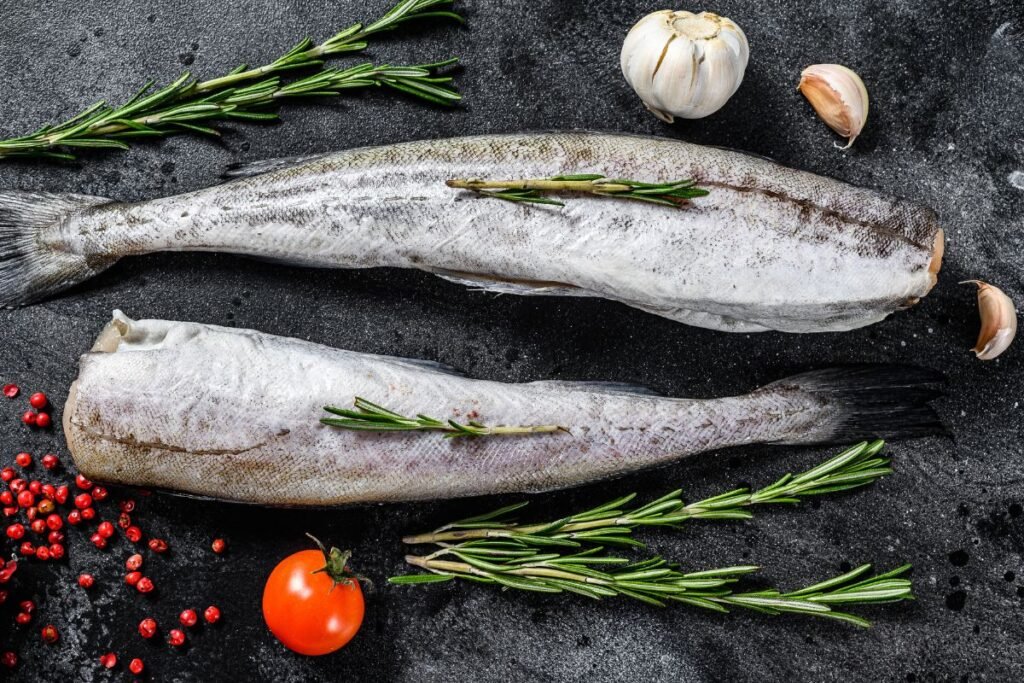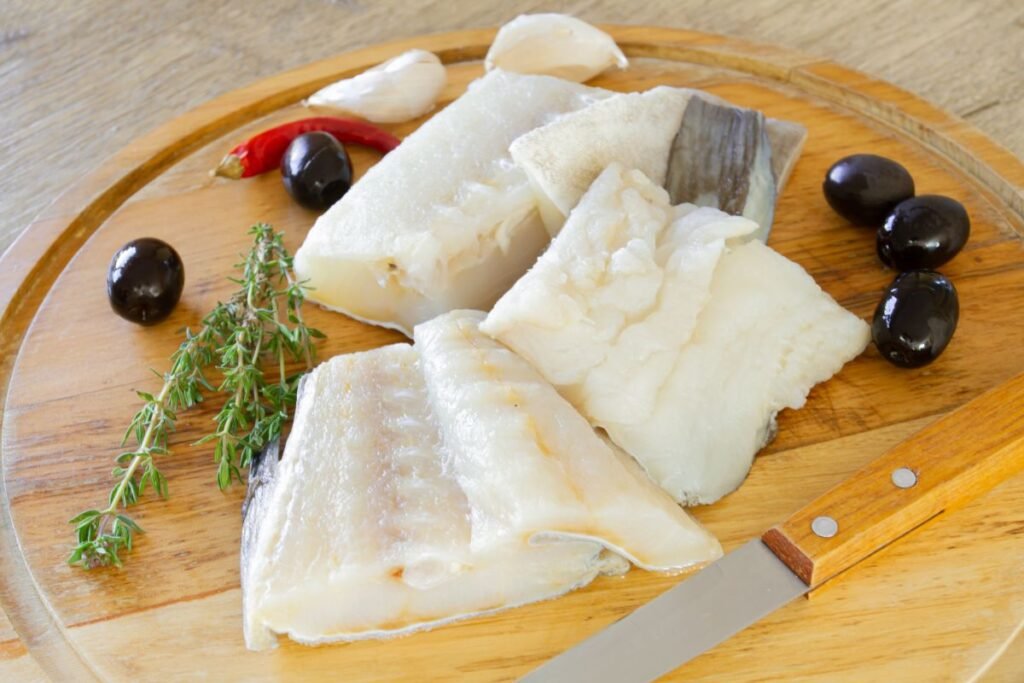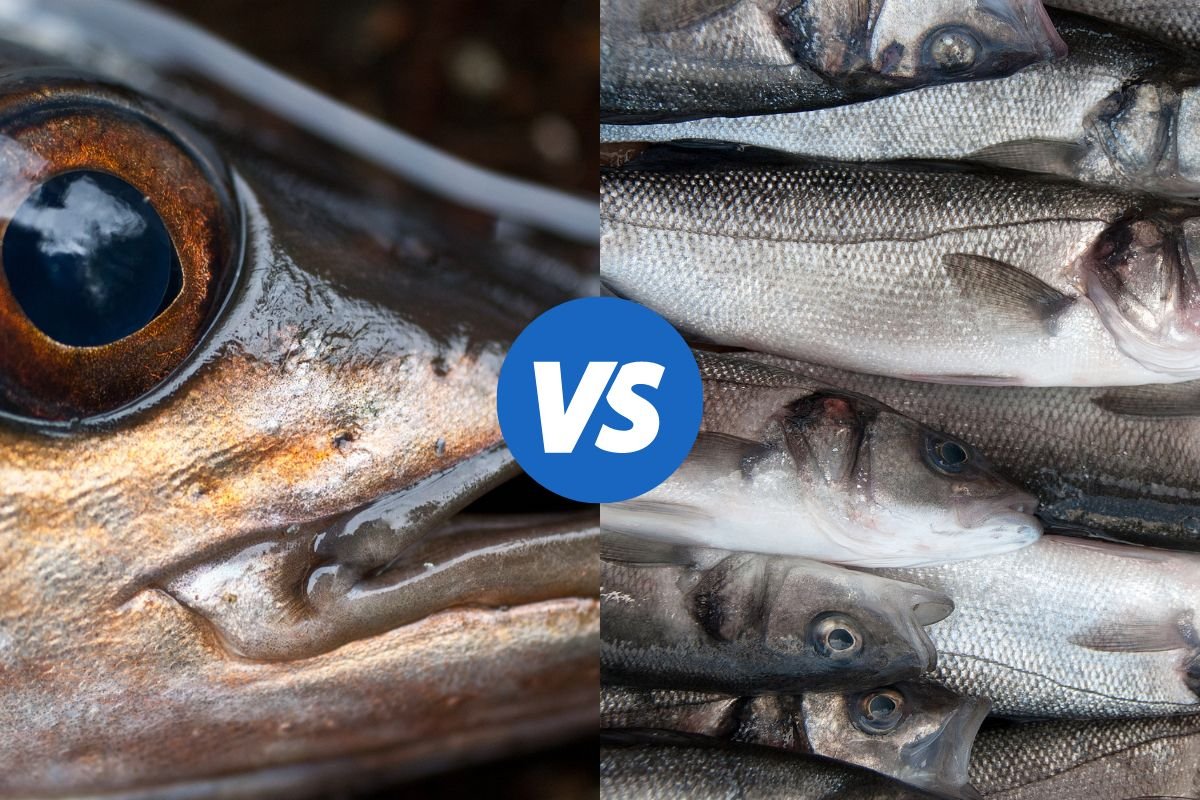Have you ever been to the market and gazed at the fish behind the glass? When I was a kid I thought fish was gross, but as years went by, fish like pollock and cod, became favorites!
What are Pollock and Cod?
Pollock and cod are two of the most popular whitefish consumed around the world. They are mild-flavored fish with a flaky texture that makes them adaptable to many recipes and cooking methods.
Pollock is a member of the cod family Gadidae. There are two main types of pollock that people eat:
- Atlantic pollock (Pollachius pollachius): Found in the North Atlantic Ocean along Norway, Great Britain, and Iceland.
- Alaska pollock (Gadus chalcogrammus): Abundant in the northern Pacific around Alaska and Russia. Also called walleye pollock.
Meanwhile, the term cod refers to several species in the cod genus Gadus:
- Atlantic cod (Gadus morhua): Lives in the waters of the northern Atlantic and is popular in European cuisine.
- Pacific cod (Gadus macrocephalus): Found throughout the northern Pacific and heavily caught near Alaska.
So while pollock and cod may look alike, they are different species within the larger codfish family. But they share similar traits like their white, flaky meat with a mild taste.
Nutritional Profile: How Does Pollock Stack Up Against Cod?
Pollock and cod provide lean, low-fat protein with important nutrients. Let’s see how they compare nutritionally:
| Nutrient | 3 oz Cooked Pollock | 3 oz Cooked Cod |
|---|---|---|
| Calories | 90 | 89 |
| Protein | 19g | 19g |
| Total Fat | 1g | 1g |
| Saturated Fat | 0g | 0g |
| Sodium | 75mg | 84mg |
| Omega-3 Fatty Acids | 460mg | 163mg |
| Niacin | 4.8mg | 5.1mg |
| Vitamin B12 | 1.4mcg | 1.1mcg |
| Selenium | 47.6mcg | 32.4mcg |
Looking at this nutritional data, we can see that pollock and cod are remarkably similar in their overall nutritional makeup. The calorie, protein, total fat, and sodium content in a 3-ounce portion of each fish is almost identical.
The main nutritional difference between pollock vs cod is in their omega-3 fatty acid content. Omega-3s are healthy unsaturated fats that are important for heart health and brain function. Pollock provides around 3 times as many omega-3s as cod. However, both fish offer a good amount of this beneficial nutrient.
Pollock contains a bit more of vitamins like niacin and vitamin B12. It also has higher levels of the antioxidant mineral selenium.
So while pollock and cod vary in some micronutrients, their macros are nearly equivalent. Both provide high-quality, nutrient-dense protein that’s low in unhealthy saturated fat.

Where is Pollock Caught Compared to Cod?
The fishing regions for pollock and cod provide clues into their supply levels and sustainability.
Alaska pollock is abundant in the northern Pacific Ocean near Alaska and Russia. In fact, Alaska pollock is one of the highest-volume fisheries in the world, with an annual catch of over 3 billion pounds. It’s also one of Russia’s most profitable seafood exports. This high supply keeps pollock affordable.
Meanwhile, Atlantic pollock is caught off the coast of New England and Canada’s Atlantic provinces like Nova Scotia and Newfoundland. Norway also manages a substantial Atlantic pollock fishery.
For cod, the majority comes from the Atlantic. Atlantic cod is fished from the coastal waters of New England, Atlantic Canada, Iceland, the North Sea near the UK, Norway, and the Barents Sea.
Pacific cod is caught in large quantities in the Bering Sea and the Gulf of Alaska. Pacific cod allowances are on the rise in recent years.
Sustainability of Pollock vs Cod Fisheries
With the troubled history of overfishing affecting cod stocks, how do pollock and cod compare today in terms of sustainability?
Fortunately, management and quotas of these fisheries have improved. Both Alaskan pollock and Pacific cod from Alaska earn a “Best Choice” rating from the Seafood Watch sustainability guide. These fisheries are well-managed with no signs of overfishing.
Atlantic pollock is a “Good Alternative” as stocks are rebuilding after being overfished.
For Atlantic cod, many regions like the U.S. and Canada have seen stocks rebound with strict quotas in place. Atlantic cod rates as a “Good Alternative.”
So pollock and cod fisheries today are much more sustainable than decades past thanks to better monitoring and regulation. This benefits consumers by providing stable availability of these healthy fish.
Flavor Profile: Cod vs. Pollock
Pollock and cod have a mild, slightly sweet flavor and moist, flaky white flesh when cooked. There are some subtle differences in taste though:
- Cod has a fuller, more pronounced flavor than pollock. It’s sweeter and more “fishy” tasting.
- Pollock has a more delicate, subtle flavor. It’s not as strong tasting as cod.
- Atlantic cod has a slightly fishier, more robust flavor while Pacific cod is milder.
- Young, wild Alaskan pollock is praised for its light, mild taste. Older pollock can taste stronger.
- Both pollock and cod pick up flavors from seasonings or sauces very nicely.
So cod is generally considered to have a somewhat superior natural flavor compared to pollock. But pollock holds up well when battered and fried or baked. Its milder taste can be an advantage in dishes with other strong flavors.

Cost Differences: Which is Cheaper, Pollock or Cod?
Here are the average prices for pollock vs cod when buying fresh fillets:
- Fresh Atlantic Pollock Fillets – $3.99/lb
- Fresh Pacific Cod Fillets – $8.49/lb
- Fresh Atlantic Cod Fillets – $7.99/lb
As you can see, pollock cost significantly less than cod. Even Pacific cod from Alaska is over twice the price of pollock.
A few reasons for pollock’s lower price:
- High supply from productive fisheries keeps prices down
- Lower consumer demand due to cod being preferred
- Difficulty distinguishing pollock fillets from cod visually
Pollock is often substituted for cod without the consumer knowing due to its similar appearance and texture. Taking advantage of pollock’s affordability makes it easier to enjoy fish more often.
Best Uses for Pollock vs Cod
The flaky, versatile nature of pollock and cod allows them to shine in a variety of recipes:
- Baking or broiling fillets
- Frying fish for fish tacos or fish and chips
- Adding to chowders, stews, and casseroles
- Cutting into chunks for fish skewers or fish cakes
- Combining with rice and vegetables for seafood bakes
Their neutral taste absorbs flavors nicely. Breading or seasoning the fillets helps vary the flavor.
Both pollock and cod work well when cooked from fresh or frozen. Their white color turns opaque when cooked through fully. Try them interchangeably in your favorite seafood dishes.
Which is Healthier: Pollock or Cod?
When it comes to nutritional value, pollock and cod are matched very evenly.
They have the same amount of protein and minerals like phosphorus, potassium, magnesium, and selenium. They are both low in fat and calories.
Pollock contains a considerably higher omega-3 content. Omega-3s provide anti-inflammatory benefits and support cardiovascular and brain health.
However, the actual amount of omega-3s in a serving of cod still provides a healthy dose of this beneficial fatty acid.
Both fish contain high-quality, complete protein to support muscle growth and satisfaction.
There are no significant differences in vitamin content except pollock has slightly more niacin and vitamin B12.
Overall, pollock and cod are both very nutritious. They make excellent regular additions to a healthy diet. Pollock offers more omega-3s for heart health, while cod provides comparable protein, minerals, and vitamins. When it comes to nutritional value, it’s a tie.
How Do They Compare for Mercury Levels?
Seafood mercury content can be a concern, especially for pregnant women and young children.
Fortunately, both pollock and cod are considered low mercury choices. Since they are smaller fish with shorter lifespans, they do not accumulate high amounts of mercury.
According to testing by the FDA, the mercury levels in pollock and cod are well below levels of concern. Eating 8 ounces of cooked pollock or cod would provide under 5% of the maximum daily mercury intake.
Pregnant women can safely eat 2 servings per week of pollock or cod. For young children, 1 serving twice a week is recommended.
So you can feel good about enjoying pollock and cod fish for their health benefits. Their low mercury levels make them safe choices.
Let’s compare their mercury levels with some other popular fish:
| Fish | Mercury Level (ppm) |
|---|---|
| Atlantic Cod | 0.111 |
| Alaskan Pollock | 0.061 |
| Salmon | 0.022 |
| Tilapia | 0.013 |
| Shrimp | 0.001 |
| Catfish | 0.088 |
| Mahi Mahi | 0.073 |
Which Type of Whitefish Makes a Better Choice?
At the end of the day, should you choose pollock or cod for your recipe or seafood meal?
When it comes to sustainability, they are evenly matched with ratings of “Best Choice” or “Good Alternative” from Seafood Watch. Both are responsibly fished.
Nutritionally, they provide the same high-quality protein, minerals, and vitamins. Pollock offers a bit more omega-3s. Cod provides a little more niacin and vitamin B12. Overall, it’s a nutritional tie.
For health, both contain low mercury levels and are recommended 2-3 times per week.
Pollock has a more delicate, mild flavor while cod tastes richer and sweeter. But pollock works well cooked in batter or sauce. It comes down to personal taste preference.
The area where pollock really dominates is cost. Its affordability makes it accessible for everyday meals. Cod costs over twice as much.
So which is better? For budget-friendly fish with plenty of lean protein and omega-3s, opt for pollock. For the best flavor, cod still retains its crown. But pollock holds its own and wins on price. Mix up your routine with both of these tasty, sustainable whitefish.
Want to see some more fish comparisons? Check out Cod Vs Haddock
Summary
Pollock and cod have subtle differences but are nutritionally similar. Pollock contains more omega-3s and costs less. Cod provides a fuller, sweeter flavor.
Both are low-mercury choices that provide lean, flaky protein. Which you choose comes down to cost considerations, taste preferences, and recipe needs. Fortunately, you can feel good choosing either of these healthy, sustainable whitefish.
I’ve had both of these fish and both are great, however, cod is my favorite personal choice when it comes to these two. Leave a comment below and tell us which is your favorite and why!


